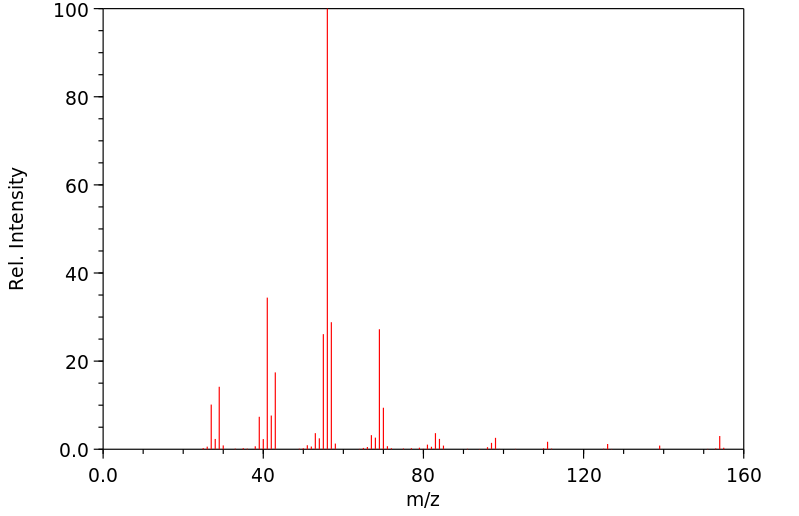2-甲基-1-癸烯 | 13151-27-4
中文名称
2-甲基-1-癸烯
中文别名
2-甲基癸-1-烯
英文名称
2-methyl-dec-1-ene
英文别名
2-methyl-1-decene;2-methyldec-1-ene
CAS
13151-27-4
化学式
C11H22
mdl
MFCD00049133
分子量
154.296
InChiKey
HLMACKQLXSEXIY-UHFFFAOYSA-N
BEILSTEIN
——
EINECS
——
-
物化性质
-
计算性质
-
ADMET
-
安全信息
-
SDS
-
制备方法与用途
-
上下游信息
-
文献信息
-
表征谱图
-
同类化合物
-
相关功能分类
-
相关结构分类
物化性质
-
熔点:-51.48°C
-
沸点:187.71°C (estimate)
-
密度:0.7506
-
保留指数:1085
计算性质
-
辛醇/水分配系数(LogP):5.7
-
重原子数:11
-
可旋转键数:7
-
环数:0.0
-
sp3杂化的碳原子比例:0.818
-
拓扑面积:0
-
氢给体数:0
-
氢受体数:0
安全信息
-
危险品标志:F
-
海关编码:2901299090
SDS
上下游信息
反应信息
-
作为反应物:参考文献:名称:简单的化学选择性催化烯烃异构化摘要:催化量的 Co(SaltBu,tBu)Cl 和有机硅烷不可逆地使末端烯烃异构化一个位置。相同的催化剂影响二烯的环异构化和应变环的逆环异构化。可以耐受强路易斯碱(如胺和咪唑)和不稳定的官能团(如环氧化物)。DOI:10.1021/ja5105602
-
作为产物:参考文献:名称:Peterson (Silyl-Wittig) Methylenation of Carbonyl Compounds Using Nation-H® Catalyzed Hydroxy-Trimethylsilane Elimination of β-Hydroxysilanes摘要:使用全氟烷磺酸(Nafion-H®)催化,通过方便的羟基-三甲基硅烷消除中间体β-羟基硅烷,显著改进了卡宾化合物通过Peterson(硅基-Wittig)甲叉化反应的效率。这些高产率的反应在室温下进行,并且后处理仅涉及催化剂的过滤。DOI:10.1055/s-1991-26371
文献信息
-
[FeIII(F20-tpp)Cl] Is an Effective Catalyst for Nitrene Transfer Reactions and Amination of Saturated Hydrocarbons with Sulfonyl and Aryl Azides as Nitrogen Source under Thermal and Microwave-Assisted Conditions作者:Yungen Liu、Chi-Ming CheDOI:10.1002/chem.201000581日期:2010.9.10[FeIII(F20‐tpp)Cl] (F20‐tpp=meso‐tetrakis(pentafluorophenyl)porphyrinato dianion) is an effective catalyst for imido/nitrene insertion reactions using sulfonyl and aryl azides as nitrogen source. Under thermal conditions, aziridination of aryl and alkyl alkenes (16 examples, 60–95 % yields), sulfimidation of sulfides (11 examples, 76–96 % yields), allylic amidation/amination of α‐methylstyrenes (15的[Fe III(F 20 -tpp)CL](F 20 -tpp =内消旋-四(五氟苯基)卟啉二价阴离子)可以使用磺酰基和芳基叠氮化作为氮源酰亚胺/氮烯插入反应的有效催化剂。在热条件下,芳基和烷基烯烃的叠氮化(16例,产率为60-95%),硫化物的硫化亚胺(11例,产率为76-96%),α-甲基苯乙烯的烯丙基酰胺化/胺化(15例,68-83) %的收率),和饱和的C胺化 H键包括环烷烃和金刚烷(8个实例中,64-80%的收率的)可以通过使用2摩尔%的[Fe来完成III(F 20-tpp)Cl]作为催化剂。在微波辐射下的条件下,氮杂环丙烷(四个例子),烯丙基胺化(五个例子),sulfimidation(两个例子),和饱和的C胺化的反应时间可以通过最多减少到H键(三个例子)16倍( 24–48小时与1.5–6小时),而不会显着影响产品收率和底物转化率。
-
From vinyl sulfides, sulfoxides and sulfones to vinyl zirconocene derivatives作者:Shahera Farhat、Irena Zouev、Ilan MarekDOI:10.1016/j.tet.2003.08.074日期:2004.2An easy and straightforward new method for the preparation of sp2 zirconocene derivatives from a wide range of heterosubstituted alkenes such as vinyl sulfides, sulfoxides and sulfones is described. In all cases, a complete isomerization of the stereochemistry is observed and only the E-isomer is obtained. The reactivity of the resulting vinylic organometallic can be increased by a transmetalation
-
A Concise Route to α′-Methoxy-γ-pyrones and Verticipyrone Based Upon the Desymmetrization of α,α′-Dimethoxy-γ-pyrone作者:Michaël De Paolis、Helèna Rosso、Matthias Henrot、Cristina Prandi、Florent d'Herouville、Jacques MaddalunoDOI:10.1002/chem.201001780日期:——Two steps is the rule: A concise synthesis of versatile α′‐methoxy‐γ‐pyrones (see scheme) is described that uses an innovative desymmetrization of α,α′‐dimethoxy‐γ‐pyrone, relying upon conjugate addition of nucleophiles. This new strategy is applied to the preparation of α‐methyl‐ and α‐carboxaldehyde‐α′‐methoxy‐γ‐pyrones and to a short synthesis of verticipyrone.
-
An <i>N</i>-Fluorinated Imide for Practical Catalytic Imidations作者:Yuno Oe、Ryuhei Yoshida、Airi Tanaka、Akiya Adachi、Yuichiro Ishibashi、Takashi Okazoe、Kohsuke Aikawa、Takuya HashimotoDOI:10.1021/jacs.1c13569日期:2022.2.9modular synthetic handle for one-step derivatization to amines, sulfonamides, and sulfamides. Furthermore, this study revealed the superior reactivity of NFC as showcased in a copper-catalyzed imidation of benzene derivatives and imidocyanation of aliphatic alkenes, overcoming the limitation of NFSI-mediated reactions.
-
Catalytic Oxidation–Reduction Hydration of Olefin with Molecular Oxygen in the Presence of Bis(1,3-diketonato)cobalt(II) Complexes作者:Koji Kato、Tohru Yamada、Toshihiro Takai、Satoshi Inoki、Shigeru IsayamaDOI:10.1246/bcsj.63.179日期:1990.1In the presence of a bis(1,3-diketonato)cobalt(II) complex, various olefins are converted to the corresponding hydrated products according to the Markownikov rule on treatment with molecular oxygen in secondary alcohol (“oxidation–reduction hydration”). Removal of water formed during the hydration reaction, especially by azeotropic method, is remarkably effective to improve yields of the hydrated products
表征谱图
-
氢谱1HNMR
-
质谱MS
-
碳谱13CNMR
-
红外IR
-
拉曼Raman
-
峰位数据
-
峰位匹配
-
表征信息
同类化合物
高密聚乙烯
香叶醇
顺式3-甲基-2-己烯
顺式-5-癸烯
顺式-5-甲基-2-己烯
顺式-5-庚烯-1-炔
顺式-4-癸烷
顺式-4-甲基-2-戊烯
顺式-4-甲基-2-戊烯
顺式-3-癸烯
顺式-3-甲基-3-己烯
顺式-3-甲基-2-庚烯
顺式-3-戊烯-1-炔
顺式-3,4-二甲基-3-己烯
顺式-3,4-二甲基-2-戊烯
顺式-3,4-二甲基-2-戊烯
顺式-2-甲基-3-己烯
顺式-2-壬烯
顺式-2-丁烯-D1
顺式-1.1.1-三甲基-2-丁烯
顺式-1-甲基-2-环丙基乙烯
顺式-1-甲基-2-乙烯基环戊烷
顺式-1-环戊基-1-辛烯
顺式-1-氘代-3-甲基-1-丁烯
顺式-(9ci)-2,3,3a,7a-四氢-4-(1-甲基乙基)-1H-茚
顺式-(2-丁烯基)环丙烷
顺式,顺式-2,4-己二烯
顺-环辛烯
顺-9-二十一碳烯
顺-6-十三碳烯
顺-5-甲基-1,3,6-庚三烯
顺-4-辛烯
顺-4-壬烯
顺-3-辛烯
顺-3-甲基-2-戊烯
顺-3-壬烯
顺-3-十三碳烯
顺-2-辛烯
顺-2-癸烯
顺-2-戊烯
顺-2-庚烯
顺-2-己烯
顺-2-丁烯
顺-2,2-二甲基-3-己烯
顺-1,3-戊二烯
顺,顺-1,9-环十六烷二烯
顺,顺,顺-环癸-1,3,5-三烯
间戊二烯
间二(4-吡啶基)苯
镁,二-2-丁烯基-







